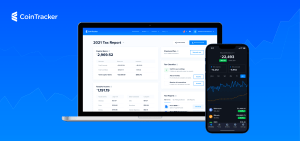The upcoming tax season is likely to prove particularly complex for crypto investors, many of whom will be paying taxes on their crypto holdings for the first time ever. In the US, the crypto industry will also grapple with new rules in the recently-passed $1.2 billion infrastructure bill that apply to digital assets, including a requirement for crypto exchanges to disclose their gains and provide the names and addresses of their customers.
Exchanges are doing their part to prepare for the impending filings. Coinbase, one of the world’s largest crypto exchanges, announced an exclusive partnership earlier this week with crypto tax and portfolio tracking provider CoinTracker, meaning Coinbase users will get access to CoinTracker’s software at a discounted price.
Over 3% of the entire global cryptocurrency market, representing over $50 billion worth of digital assets, is tracked on CoinTracker, its CEO and cofounder Jon Lerner told TC in an interview. The platform allows users to see all their crypto activity, including NFTs and decentralized finance (DeFi), in one place. Over 100 different exchanges and dozens of blockchains are integrated natively on CoinTracker, making it easy for users to gain a full picture of their crypto holdings, Lerner said.
The company announced today that it has raised a $100 million Series A round led by Accel, valuing the company at $1.3 billion. Both existing and new investors participated in the Series A, including General Catalyst, Initialized Capital, Y Combinator Continuity, 776 Ventures, Coinbase Ventures, Intuit Ventures, Kraken Ventures, and a number of prominent angel investors from fintech and crypto companies.

CoinTracker’s interface on desktop and mobile Image Credits: Cointracker
CoinTracker last raised $1.5 million for its seed round in 2018, which is when Lerner noticed the crypto markets evolving in a significant way.
“Back in 2018, there were a few top exchanges, and people were starting to play with Ethereum. Now, DeFi and NFTs have become really big. We’ll continue to see a proliferation of use cases in crypto,” Lerner said. He hopes to use the funding to broaden CoinTracker’s breadth and depth of integrations to support as many use cases as possible.
CoinTracker plans to use the funding to scale to ten million users in the next three years, Lerner added, though he declined to share how many users it has today. It also plans to expand its team, starting with two new hires it announced in conjunction with the fundraise – a new head of engineering and product lead, Gaurav Garg and Zack Reneau-Weeden. Garg was formerly a VP of engineering at Uber and Google and Reneau-Weeden was head of product at Robinhood’s crypto arm, according to the company.
The company grew its team from 10 people at the start of 2021 to about 40 people today, Lerner said. He expects CoinTracker’s headcount to grow to 100 people or more by the end of 2022.
While CoinTracker’s portfolio tracking functionality has users across the globe, its technical support services are currently only available to customers in the US, UK, Canada and Australia. Portfolio tracking on the platform is free to users who only need basic functionalities, and is available to customers with a broader set of needs starting at $14 a month.
For US-based users with relatively simple crypto holdings, an annual tax plan with CoinTracker is free. The company’s paid tax offerings range from $49 per year to “multiple hundreds” depending on the complexity of the user’s portfolio, according to Lerner.
The portfolio tracker enables the tax functionality by collecting the data a user needs in order to file year-round and allowing them to file with the click of a button, Lerner said. The product’s ease of use has been the biggest driver behind its traction, he noted.
When asked about the risks facing the company, Lerner said the biggest one is that the crypto industry as a whole may not become tax-compliant in time to avoid being hit with penalties and audits. A lack of awareness and education about how to pay taxes on digital asset holdings is one of the biggest hurdles for users, he added.
“It’s kind of our job to help people make an informed decision on how to do this reasonably. We just take the friction away and make it super easy. You just connect your wallets, connect your exchanges, everything, retroactively, and going forward it is automatically synced. We’ll put in smart defaults,” Lerner said. “If you’re a power user, or you’re working with a CPA, you can go in and tweak those advanced settings. But taking a reasonably smart default approach takes the friction away.”










